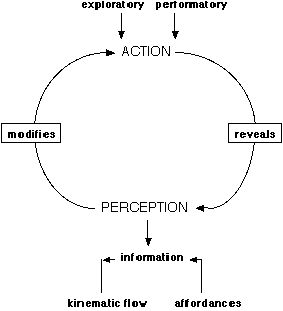Circular causality between perception and movement in order to achieve a particular action relative to a particular task. This type of causality is exemplified by James J. Gibson (1979) in his book The ecological approach to visual perception as follows: “We perceive in order to act and we act in order to perceive.”, a standpoint captured in the figure below. Gibson was really the first to challenge the validity of studying perception separately from action. A similar approach to his was formulated by the neurologist Viktor von Weizsäcker (1940/1973) with his Gestalt Circle Theory as put forward in his book Die Gestaltkreislehre Theorie der Einheit von Wahrnehmung und Bewungung (The Gestalt circle of the unity of perception and movement). He did not, however, treat the unity or coupling of perception and action in such a way that it could be empirically evaluated. For him, the circle between perception and action could only be broken when the brain was in a pathological state. In his turn, Nikolai Bernstein (1967) in his book The coordination and regulation of movement also wrote about the inseparability of perception and action, as can be appreciated from the following citation: “The central effectors achieve co-ordination of movements only by plastically reacting to the totality of signals from the afferent field” (p. 107).

Perception-action coupling and circular causality: any action has perceptual consequences, which reveal information about the stability of the observer relative to the environment by means of kinematic (optical, auditory etc.) flow and about the possibilities for further action by means of affordances. In turn, the perceptual information generated serves to guide or modify the ongoing action. Performatory actions, unlike exploratory actions, are directed toward achieving a specific goal such as grasping an object, and in this sense they are prospectively controlled executive functions. In short, actions constrain or enhance what is perceived and what is perceived constrains or guides subsequent actions. This circular causality, however, is not fully deterministic in that intentions can enter it as stochastic functions that may change in unpredictable ways how perception feeds off action and vice versa.
See Action, Affordance, Circular (or non-linear) causality, Common coding, Correspondence problem, Direct realist account, Ecological psychology, Executive function, Motor ability, Motor development, Motor skill, Movement (or motor) coordination, Organism-environment mutualism, Perception, Perception development, Prospective control (psychology), Stochsticity, Two visual systems hypothesis